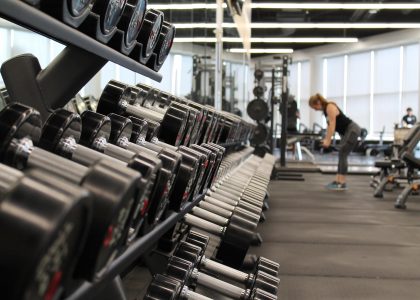Intensity techniques are particularly valuable in bodyweight training. The adjustment does not work in self-weight training simply by adding weight plates, but follows different progression levels.
To be able to climb these levels, you need knowledge of various intensity techniques.
The cool thing about it: You can not only make your training more difficult, but also make it easier for beginners when applied the other way round and thus always ensure a challenge – without excessive demands
Basic information on intensity techniques in training
Intensity techniques are important in any form of training. It is also used when training with weights.
However, the importance increases the less external aids you use for your training.
Say: In bodyweight training, methods to make training more difficult (or to make it easier) play an even more important and decisive role in ensuring steady progress.
Just imagine the following, simple case study from training with your own body weight.
You want to train your arms and chest with the push-up exercise. Now you have two people of different fitness:
- Person 1, let’s call her Hans, has not trained for many years, is around 40 years old and something overweight. Do you think that Hans can do 10-15 clean reps of classic push-ups on the floor?
- Person 2, let’s call her Jürgen, is an active club athlete, around 30 years old and quite fit. Do you think that Jürgen is challenged enough with 10-15 clean repetitions of the classic push-up to improve his performance?
You probably – like me – answered both questions in the negative.
This is exactly where intensity techniques come into play.
In the following I will give you an overview of intensity techniques, especially for bodyweight training. In weight training – especially in the “Muckibude”, intensity techniques are unfortunately often equated with: Getting the most out of your muscles.
They can do so much more and are not just pure methods for extremely strenuous strength training, which is specially designed to provoke muscle growth stimuli.
Intensity techniques answer the question: How can we adapt the form of training – especially in bodyweight training – so that it fits perfectly to the athlete’s level of performance, in order to offer him a challenge without being overwhelmed?
What does a challenge mean?
Well, this mainly means your muscles. She should feel that things cannot go on like this. In other words: it should get a stimulus to become stronger. You can do this especially if you choose the difficulty of the exercise so that you can do between 8-12 repetitions and then have to take a short break because the muscle is tired from the exertion
Let’s start now with the presentation of the most important intensity techniques.
You will also receive further practical examples so that you can easily incorporate the techniques into your training.
Leverage
The easiest way to customize exercises.
The motto is:
Change your center of gravity so that the muscles to be trained with the exercise bear as much weight as you need for a good training stimulus.
Let’s now look at this technique using a well-known example: the push-up.
Usually you do this right on the ground. But honestly: Which untrained person can do 10 clean repetitions in a row? Hardly any …
For the well-trained, however – as already mentioned – a piece of cake …
The solution: put your hands higher for the untrained – put your feet higher for the trained – until the intensity is right, in order to be able to set a good training stimulus.
This change in body position also changes the body’s center of gravity and accordingly there is less or more weight on your arms.
Time under tension
This means the time in which your muscle is under tension during the exercise. The longer the muscle is under tension, the more strenuous it is for it.
The motto is:
Change the pace of the exercise so that you shape the time under tension in such a way that you can set a good training stimulus.
When doing push-ups, we usually do it in such a way that we lower ourselves quickly and also push ourselves up again relatively quickly (as long as there is still strength).
But what if we gave ourselves 3 seconds for the lowering – i.e. the eccentric movement phase – and then explosively pushed ourselves up again? Or even 6 seconds?
We make the exercise quite difficult and thus only manage about 2/3 or less of the repetitions that we would have done at “normal speed”.
This can be made any further and is therefore also a good working intensity technique.
Intensity techniques additional tip: eccentric repetitions and isometric holding
One way you can make difficult exercises like one-arm pull-ups or one-arm push-ups easier or how you can even manage to train for them are eccentric repetitions or isometric holds.
To do this, you need to know the following:
- Concentric means overcoming muscle work – so when you push yourself up from the floor into the push-up starting position, e.g. the back of your upper arm (triceps) concentrically
- Eccentric means yielding muscle work – when you lower yourself from the push-up position to the floor, the back of your upper arm (triceps) does eccentric muscle work
- Isometric means holding muscle work – that means you stay in one position – when doing a push-up, for example, lowered but not all the way down and hold this position
One of my book tips is Overcoming Gravity by Steven Low *. In this bodyweight training standard work, Steven also records how you can make the time under tension in these three training variants comparable:
- 1 concentric repetition corresponds to approx.
- 2 seconds of isometric muscle work and
- 3 seconds of eccentric muscle work.
This means that eccentric repetitions are a lot easier than concentric repetitions. You can take advantage of this by incorporating eccentric repetitions into your training to make certain exercises easier for you. To explain this using the example of a pull-up: You may not be able to do a classic pull-up, so you would jump on the bar and slowly lower yourself.
You can also incorporate isometric hold in the middle of a concentric repetition to make the exercise more difficult. So you do a push-up, lower yourself, hold for 2 seconds in half, then go all the way down and finally push yourself up again. That would be a repetition with built-in isometric hold.
Range of Motion
This is about the range of motion of the exercises performed.
The motto:
Always perform the exercises with the full range of motion of the joints involved, unless you want to make the exercise easier.
It is important to remember that a push-up doesn’t just include your elbow joint. When you push up, for example, you also push yourself out of your shoulders, when you lower your chest briefly touches the floor.
With bodyweight training, it is always important to me that you can use your body well in all its range of motion. Because that is always joint hygiene.
Use it or loose it.
You probably know this sentence and it also applies to our joints.
If you don’t regularly use the full range of motion available to you, your joint will atrophy and sooner or later will start to hurt. Combined with an anti-inflammatory diet, your joints will love it!
If you want to get more agile, you can also use mobility training.
One-sidedness
The supreme discipline in bodyweight training.
The problem with this: The jump from two-legged or two-armed exercises to their one-sided variant is a big one.
The motto:
Do exercises one-sided to make them more difficult. In order to create this progression, begin to shift your body weight more and more to one side of the body, step by step, until you can leave the second limb completely out for support.
The push-up is a good example here again. A young, fit man can easily do 20 proper push-ups. Which would be a bit too easy for him for proper strength training.
The Archer Push Up can be a great pressure exercise for your whole body training for advanced users. This is how you apply intensity techniques correctly in order to eventually manage progressions like the one-armed push-up.
But the one-armed push-up is such a great progression level that the person probably won’t be able to manage one at all at the beginning.
0 repetitions of an exercise don’t necessarily make you stronger either …
Therefore, you should slowly put more weight on one arm. You can do this with Archer Push Ups, for example, or by placing an arm on a ball. This will make the exercise more difficult and prepare yourself for higher progressions.

Training methods
You have now learned how to change the exercise yourself to make it easier or more difficult.
There are also other ways and possibilities to make your training more challenging.
The motto:
Select training methods that match your goals and use them in such a way that they help you to always be challenged but never overwhelmed.
You don’t always have to train 0/8/15, you can always set new stimuli with the clever use of training methods.
You can find a good overview of classic training methods in this article.
I would like to introduce a few examples to you here.
In Supersets you can combine two exercises for the same muscle group. How to proceed:
You do a difficult exercise – for example, push-ups with raised legs and do 1-6 repetitions, then you do an easier variant (for example classic push-ups) on it, namely 6-12 repetitions. Then there is a short pause (1-2 minutes) and you repeat this 1-2 more times.
Decreasing sentences are also tough.
You need 3 variations of an exercise for this. First you do the difficult variant max. 12 times or until you can’t anymore (push-ups with feet raised). It then continues without a break with max. 12 repetitions of classic push-ups. After all, you do with max. Continue doing 12 repetitions with knee support. That was a really tough sentence.
Additional tips
What you should pay attention to with all the possibilities to make your workout more difficult or to make exercises easier: The right form of exercise!
Compensatory movements of any kind are not desired, the first repetition should be as good as the last – then you come to technical muscle failure, which is a good benchmark for effective training.
You can also work with an unstable surface to challenge your sense of balance and thus make every conceivable exercise a little more difficult or bring about other aspects. For example, how about a plank with your feet on a ball?
Quarter repetitions are also another way to get a little more out of a training set: For example, you would lower yourself during a push-up, then just press up a little – a quarter of the normal movement – then go all the way down and finally that perform normal concentric repetitions.
Intensity techniques – the bottom line
You now know all the options there are to adapt your training perfectly to you. You can of course also combine different intensity techniques. How about, for example, a one-arm push-up at the table as a progression level to learn one-arm push-up? Or a squat with offset feet, where you get up from the armchair? So you can put more weight on one leg than the other and take a step towards the pistol squat.
The exercise is too difficult for me? Or too easy?
You can now delete these words from your dictionary.
Here I have summarized all of the key phrases for you:
- Change your center of gravity so that the muscles to be trained with the exercise bear as much weight as you would for a good one You need training stimulus.
- Change the pace of the exercise execution so that you structure the time under tension in such a way that you can set a good training stimulus.
- Always perform the exercises with the full range of motion of the performing joints, unless you want to make the exercise easier.
- Do exercises one-sided to make them more difficult. In order to create this progression, start to shift your body weight more and more to one side of the body, step by step, until you can leave out the second extremity for support.
- Select training methods that match your goals and use them in such a way that they help you to always be challenged but never overwhelmed.
- Always carry out the exercises with perfect technical execution.







